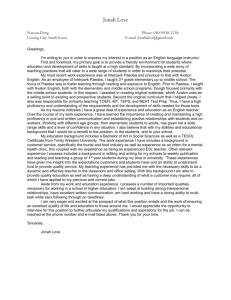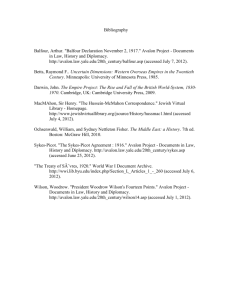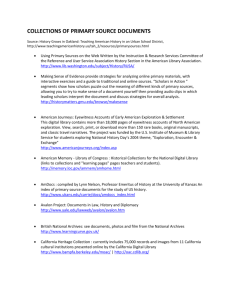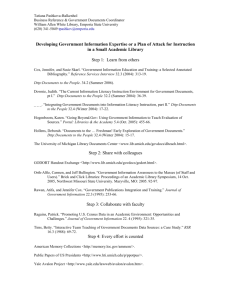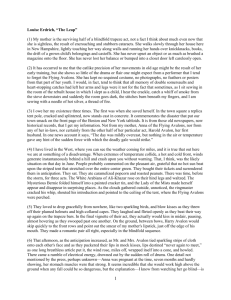PowerPoint Resentation - Office of Public Engagement
advertisement
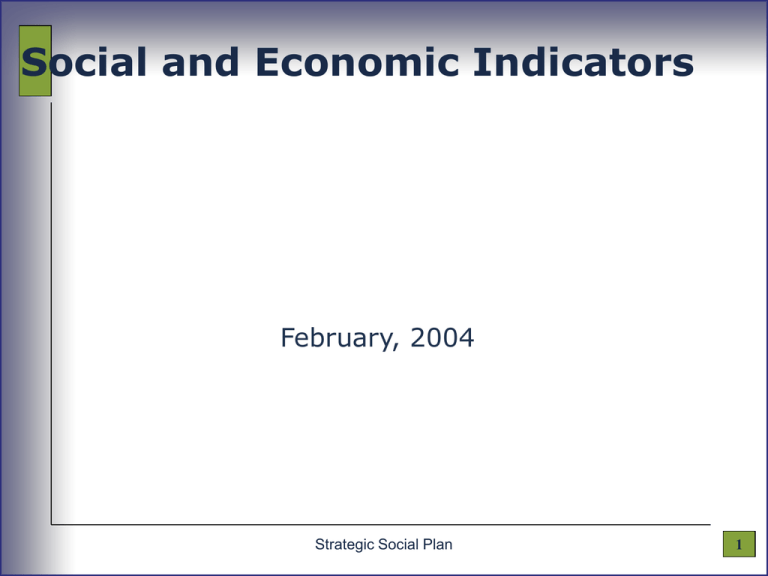
Social and Economic Indicators February, 2004 Strategic Social Plan 1 Overview SSP Vision and Goals How do we measure progress Indicators – what, why, who Key indicators for social and economic development Strategic Social Plan 2 SSP Vision Healthy, educated, distinctive, self-reliant and prosperous people living in vibrant, supportive communities within sustainable regions. Strategic Social Plan 3 SSP Goals Vibrant communities and regions in which people actively participate in their collective well-being. Sustainable regions based on strategic investment in individuals, families and communities. Self-reliant, healthy, educated individuals and families living in safe, nurturing communities. Integrated and evidence-based policy development and monitoring as the foundation for the design, delivery and evaluation of programs and services. Strategic Social Plan 4 Indicators What are they? Why have them? Who picked them? Where does the information come from? Strategic Social Plan 5 What Are Indicators? Measurements – line on the wall “A way of seeing the big picture by looking at a smaller piece of it. They tell us which direction we are going: - Up or down, forward or backward - Getting better or worse or staying the same.” Key areas – have social and economic indicators, and are working on environmental and resource indicators. Allow comparisons Urban:rural Region:region Province:Canada internationally Strategic Social Plan 6 Why Have Indicators? Measure our progress – change over time Are we doing the right things? Are we doing them the right way? Are we making any difference? Helps us focus on the real problems not just symptoms see the bigger picture recognize common goals - develop collaborative solutions Strategic Social Plan 7 Who Picked The Indicators? Key social and economic indicators In use nationally and internationally. Selected by Dr. Doug May, Memorial University. Advice from Premiers Council, Regional Steering Committees, university academics and government departments. Strategic Social Plan 8 Where did the Information Come From? Memorial University Government of NL Education Finance Health and Community Services Human Resources and Employment Industry, Trade and Rural Development Justice Tourism, Culture and Recreation Youth Services and Post-Secondary Education Women’s Policy Office Statistics Canada Human Resources Development Canada Canada Customs and Revenue Agency Strategic Social Plan 9 Where is the Information Available Now? www.communityaccounts.ca Strategic Social Plan 10 Who can access the data? The Community Accounts are publicly accessible Government and community organizations are encouraged to access the information to help them make informed decisions Community Accounts have a wealth of social and economic information (environment and natural resources in progress) and can be accessed at neighbourhood, community, regional and provincial levels. Strategic Social Plan 11 Quality of Life Half of people surveyed in the province in 2002 said their lives were better than they were five years ago 63% rated their quality of life as Very Good to Excellent ranges from 67% in NE Avalon to 57% in Cormack-Grenfell SSP Region Strategic Social Plan 12 Healthy People Disease Mortality rates for heart attacks and strokes, etc down by about half since 1979 but… compared to Canada heart attacks for both men and women are about 20% higher strokes, etc. are about 31% higher for men and 18% higher for women Strategic Social Plan 13 Healthy People Length of Life Living longer than we used to but… Compared to Canada we don’t live as long - NL men 75.2 years, NL women 80.2 years - Cdn men 76.3 years, Cdn women 81.7 years NL women live disability free longer than Canadians but NL men do not Strategic Social Plan 14 Healthy People Lifestyle Compared to Canada… Less physically active; women less active than men Smoking rate declining but still higher Daily smokers (population age 12+) - 24% in St. John’s - 33% for Health Labrador - NL – 25% - Canada – 21% Heavy drinking rates are higher 40% of men and 16% of women drinkers Strategic Social Plan 15 Educated People Literacy and Numeracy Literacy skills of adults (aged 16-69) Evidence not current (1989) Not available below provincial level In 1989 - 24% could not deal with everyday reading demands (Canada – 16%) - 36% could handle more limited range (Canada - 22%) - 39% had sufficient skills for everyday requirements (Canada – 62%) New data available mid 2005 Strategic Social Plan 16 Educated People Literacy and Numeracy 15 year olds scored lower than the Canadian average in reading, science and mathematics Reading - Urban schools at Canadian average – only Alberta & BC higher than NL - Rural schools below Canadian average – only New Brunswick lower than NL Strategic Social Plan 17 Educated People Education levels of population In 2001 compared to 1979 Higher proportion has completed high school Higher proportion with university degrees Three-quarters of high school graduates now enroll directly in college or university Strategic Social Plan 18 Educated People Regional Variations - Ages 25-29 NE Avalon Labrador Central Cormack-Grenfell Eastern Avalon No HS 11% 17% 28% 28% 28% 30% Province Canada 21% 15% Strategic Social Plan Univ Grad 28% 8% 11% 12% 9% 8% 18% 26% 19 Prosperous and Self-reliant People Income and equity Personal income per capita is increasing but… - 25% lower than Canada over past decade - 1999 : NL - $15,500, Can - $21,300 – NE Avalon - $18,400 – Labrador - $18,100 – Cormack-Grenfell – $14,000 – Eastern –$13,900 – Central – $13,900 – Avalon – $13,200 Strategic Social Plan 20 Prosperous and Self-reliant People Assets Compared to Canada in 2001… More people own their own homes - 78% in NL vs. 66% for Canada – Range: 70% in NE Avalon to 89% in Avalon Housing was about 47% cheaper - Average value of $76,283 in NL vs. $162,709 in Canada – Range: Eastern $52,519 to NE Avalon at $111,249 Strategic Social Plan 21 Prosperous and Self-reliant People Poverty Based on after-tax income in 2000 18% of children were living in poverty up from 15% in 1991 higher than Canada at 13% Based on Market Basket Measure – 2000 31.6% of 61.3% of 20.9% of 10.8%) 43.0% of 11.7%) children (Canada 16.9%) lone-parent families (Canada 35.6%) two-parent families with children (Canada elderly unattached individuals (Canada Strategic Social Plan 22 Prosperous and Self-reliant People Employment In 2001 52% in labour market worked all year - Range: Eastern 37% to NE Avalon at 64% 43% worked for an average of 25 weeks - Range: Eastern 61% to NE Avalon at 32% 5% could not find work at any time in 2001 - Range: Eastern 2% to Avalon at 7% Strategic Social Plan 23 Prosperous and Self-reliant People Self-reliance Newfoundlanders and Labradorians depend more on government transfers. Most people who get social assistance only receive it for a short time. Less than 20% of people who get social assistance receive it continuously for six or more years. Strategic Social Plan 24 Safe Communities Feeling Safe Most women and most men feel safe walking alone in their neighbourhoods at night Considerably higher than Canada Fewer women than men Crime Crime rate is lower than Canada Rate of sexual assault higher than for Canada; almost all victims were women Strategic Social Plan 25 Safe Communities Children needing protection In July 2002 there were 5407 children in need of protection - St. John’s Health Region –1824 Eastern – 782 Central – 650 Western – 1048 Grenfell – 55 Labrador - 1048 Strategic Social Plan 26 Vibrant, Distinctive and Supportive Communities Business Environment 46% of all jobs in the Province were clustered within four industry sectors in 2002: Public Administration Health Care and Social Assistance Retail Trade Education 13% 13% 10% 10% Fish harvesting and fish processing in top four in Eastern Region; fish harvesting in Avalon. Health Care and Social Assistance - at least 11% of jobs in all Regions except Labrador. Strategic Social Plan 27 Top four industry sectors NE Avalon – 51% Public Administration – 17% Educational Services – 12% Health Care & Social Assistance – 11% Prof., Scientific & Technical Service – 11% Avalon – 44% Fish Processing – 13% Health Care & Social Assistance – 11% Construction – 11% Fish Harvesting – 9% Strategic Social Plan 28 Top four industry sectors Eastern – 48% Fish Processing – 13% Health Care & Social Assistance – 13% Retail Trade – 9% Fish Harvesters – 8% Central – 42% Health Care & Social Assistance – 12% Public Administration – 12% Retail Trade – 10% Educational Services –8% Strategic Social Plan 29 Top four industry sectors Cormack-Grenfell – 45% Health Care & Social Assistance – 18% Retail Trade – 10% Educational Services – 9% Public Administration – 8% Labrador – 51% Public Administration – 20% Retail Trade – 14% Mining and Oil and Gas Extraction – 10% Educational Services – 7% Strategic Social Plan 30 Sustainable Regions Demographic changes Population dropped 10% from 1991-2001: Eastern, Central and Cormack-Grenfell dropped about 15% NE Avalon dropped less than 1% Highest decline in country 1996 - 2001 –1.2% in NE Avalon to –11.5% in Eastern Births dropped 62% since 1972 Fertility rate: 1.3 in NL vs. 1.5 for Canada Number of births and deaths almost equal Strategic Social Plan 31 Sustainable Regions Migration More people left the province than entered between 1977 and 2002 Half of those who left the province in 1991 to 1996 had completed post-secondary About three-quarters of postsecondary graduates remain in the province for at least one year after graduation Half who left in 2001-02 were aged 15 to 29 but only 39% of those who entered Strategic Social Plan 32 Linking social and economic development Better health is linked to: Being True employed in all regions Worse health is linked to: Being True unemployed in all regions Strategic Social Plan 33 Linking social and economic development Better health is linked to: Higher True income in all regions Worse health is linked to: Lower True income in all regions Strategic Social Plan 34 Linking social and economic development Better health is linked to: Higher True education in all regions Worse health is linked to: Lower True education in all regions Strategic Social Plan 35 Education levels make a difference to income In a 2001 survey, more than three-quarters of those with high school or lower earned less than $25,000 — about 60% of them earned less than $15,000. Only about 20% of university graduates reported earning less than $25,000 in 2001. Strategic Social Plan 36 Workshop Results To the question “In 5 years time, which Indicators would need to change positively to know we are impacting social and economic development in the province?” Participants consistently replied “Lifestyle” Education levels and literacy Poverty levels Employment Diversification of business Number of children needing protection Population decline and net migration Strategic Social Plan 37 Conclusions Using evidence for planning and decision making requires a shift in thinking from using anecdotes to critical analysis of solid and reliable information Need to reflect on evidence and ask question Does the evidence support the directions and priorities my organization is taking? This will allow us to: Understand the root causes Know our communities better Develop sound approaches to what works Target our programming and services better Focus on outcomes Be proactive in being accountable Strategic Social Plan 38

